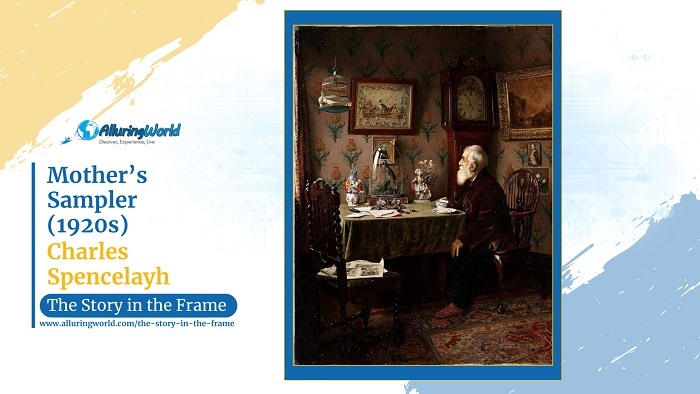Painted by Charles Spencelayh, Mother’s Sampler is an unnamed scene that presents a contemplative and somewhat melancholic portrayal of solitude, and as unlike his more domestic and familial works, this piece captures a moment of quiet isolation. As there is no specific date when this interesting artwork was created, even though some might suggest that this was created in the 1920s, it is estimated with certainty that it was created in the early 20th century, with the interior scene reflecting Spencelayh’s ability to evoke emotional depth through meticulous detail and subtle lighting. The painting’s subdued tones and focused composition invite viewers to ponder the nature of introspection and the weight of quiet moments.
About the Painter:
Charles Spencelayh (1865–1958) was an English painter known for his highly detailed and realistic still lifes, as well as his evocative genre scenes. His work often depicted domestic subjects, with a particular focus on the ordinary yet meaningful moments in life, and since he was a master of light and texture, bringing a sense of warmth and humanity to the scenes he painted, his ability to capture subtle emotional moments and the rich textures of everyday objects earned him acclaim during his lifetime, though he remains somewhat lesser-known today compared to some of his contemporaries.
Inspiration and Reasons Behind the Painting:
This painting likely reflects Spencelayh’s exploration of the more introspective aspects of human experience where unlike his depictions of bustling family life, this scene delves into the quiet moments of contemplation that often go unnoticed. The presence of the tea, the painting, the birdcage, as well as the stuffed parrot, and the solitary manly figure suggests a moment of escape or reflection, with other words a pause in the rhythm of daily life. Additionally, this could be interpreted as a commentary on the isolation that can exist even within familiar surroundings, or simply a study of a quiet moment.
What is Depicted in the Painting:
The painting shows a lone man seated in a living room with his gaze not clearly seen whether it is fixed on a painting or birdcage. He is holding a cup of tea, suggesting a moment of quiet contemplation, and as the room is sparsely furnished, it creates a sense of emptiness that reinforces the man’s isolation. The man’s posture and expression suggest a sense of introspection or perhaps even melancholy, while the painting or birdcage becomes a focal point as it draws the viewer’s attention to the man’s inner world. The overall scene is one of quiet solitude, inviting viewers to ponder the man’s thoughts and emotions.
Colors and Techniques:
Spencelayh’s color palette in this scene is subdued, featuring muted browns, greys, and creams that create a sense of quietude. The lighting is soft and diffused, casting gentle shadows that enhance the sense of depth and atmosphere, while the textures of the man’s clothing, the furniture, and the objects in the room are rendered with meticulous detail, adding a sense of realism to the scene. The use of light and shadow creates a sense of depth and dimension, drawing the viewer into the man’s solitary world.
Conclusion:
Overall, this unnamed scene by Charles Spencelayh, simply referred to Mother’s Sampler, offers a poignant portrayal of solitude and introspection. Through his expert use of light, texture, and composition, Spencelayh captures a moment of quiet contemplation, inviting viewers to reflect on the nature of isolation and the inner lives of individuals, and while diverging from his more typical depictions of domestic warmth, this painting showcases Spencelayh’s versatility and his ability to evoke emotional depth through the subtle details of everyday life. It serves as a reminder that even in moments of solitude, there is a rich tapestry of thoughts and emotions waiting to be explored.

